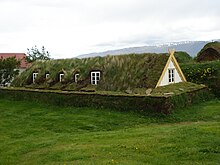Icelandic turf house
[1] Turf houses were the product of a difficult climate, offering superior insulation compared to buildings solely made of wood or stone, and the relative difficulty in obtaining other construction materials in sufficient quantities.
Oak was the preferred timber for building Norse halls in Scandinavia, but native birch had to serve as the primary framing material on the remote island.
The floor of a turf house could be covered with wood, stone or earth depending on the purpose of the building.
The first evolutionary step happened in the 14th century, when the Viking-style longhouses were gradually abandoned and replaced with many small and specialized interconnected buildings.
Then in the late 18th century a new style started to gain momentum, the burstabær, with its wooden ends or gaflar.



